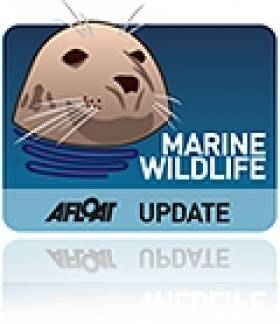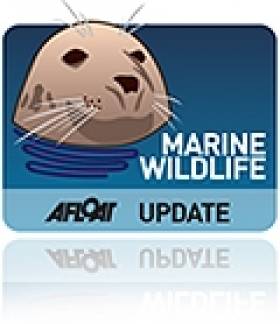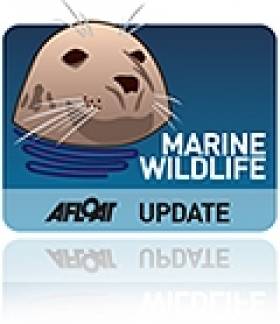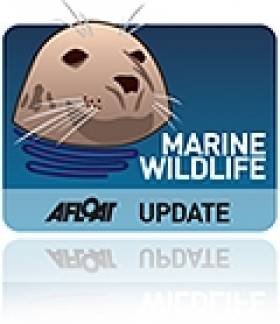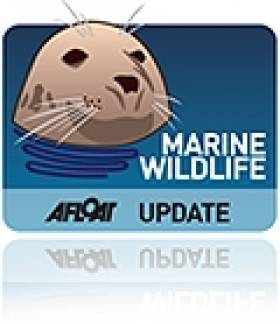Displaying items by tag: Dusty
Dusty the dolphin last weekend treated two SCUBA diving sisters to an encounter they will never forget, as RTÉ News reports.
Jessica and Jennifer Smith were diving with their father Finbar as part of a group with the Burren Sub Aqua Club last Saturday (1 May) when they were approached by the inquisitive bottlenose, who has been a fixture of the West Clare coast for some 20 years.
Previous encounters have been mixed — in particular an incident reported in Doolin some years ago in which a woman was hospitalised.
But the teens were delighted to meet a much calmer Dusty, who may have been surprised to find humans in the water after months of restrictions prevented group dives.
RTÉ News has more on the story HERE.
Dusty The Dolphin Makes A Friend At Inis Oírr
#MarineWildlife - Dusty the dolphin earned a measure of infamy in previous years after attacking a number of bathers at her former home in Doolin.
But the Wild Atlantic Way’s other resident bottlenose – after Dingle's celebrated Fungie – was in a much more agreeable mood in recent days, as a new video captured by visitor Elaine Farrell shows her adorable encounter with a snorkeller at Inis Oírr.
Dusty appears perfectly calm as she rolls over in the water for a belly rub from the diver, who was perched at the stern of a boat moored in the Aran Islands harbour.
However, as cute as that encounter might be, the Irish Whale and Dolphin Group’s Dr Simon Berrow warns that Dusty and other dolphins like her are still wild animals — and getting close to them can be dangerous.
“Our advice would be: don’t swim with the dolphins,” he said, adding: “Respect their distance and don’t do anything stupid. It’s hard to know what will set off aggressive behaviour.”
Elsewhere, video from the Copeland Islands off Donagahdee show a lazy seal taking it easy on a dinghy moored off the Irish coast recently.
Woman Tells Of 'Pure Terror' In Doolin Dolphin Incident Last Summer
#MarineWildlife - The swimmer who suffered serious injuries when she was attacked by Doolin's formerly resident dolphin has spoken of the "pure terror" of the incident last summer.
As previously reported on Afloat.ie, the woman was hospitalised after being stuck by the snout of Dusty the dolphin, whose behaviour had grown increasingly hostile towards swimmers in the Co Clare harbour over the summer.
Valerie Ryan spoke out some weeks later over the incident, calling for a total swimming ban in the area as she outlined the extent of her injuries, which included eight spinal fractures, two broken ribs and lung damage.
More recently, she recounted her experience for the Guardian, noting how Dusty "went ballistic" after she entered the water to join another swimmer ("I found out afterwards that she's very territorial when she us with somebody") and rammed Ryan from behind before she could climb out.
"All these people on the pier were staring down at me open-mouthed," she recalls. "Dusty was still in the water beside me, her tail flapping crazily. That was more frightening than anything: I thought, if she hits me with her tail, I could go under; I’m gone."
Yet despite the shock of that day, Ryan says she doesn't have "any anger towards Dusty. I respect her. But I was in her territory and she’s a wild, unpredictable animal. People need to know that."
The Guardian has much more on the story HERE.
Doolin's Dolphin Safe From Harbour Blasting Works Says IWDG
#MarineWildlife - The Irish Whale and Dolphin Group (IWDG) has allayed concerns over the fate of Doolin's resident dolphin Dusty as work begins on the Co Clare town's new pier.
Despite the distress caused by her attacks on swimmers last year, Dusty has many loyal supporters - one of whom, Jan Ploeg, shared with the Sunday Independent concerns about the effect of underwater sound waves produced by blasting works in Doolin harbour on the sensitive cetacean.
However, the IWDG's Dr Simon Berrow says there's little to worry about, as Dusty is currently living and feeding at Inisheer, some 8km from the blast site, "so there will be no impact on her".
The IWDG is presently monitoring a 500m zone around the blasting works using passive acoustic monitoring through a hydrophone to ensure no marine mammals are affected by the potentially damaging sound waves.
Doolin's Dolphin Dusty 'More Jumpy' Than She Used To Be
#Dusty - Renewed warnings have been made to the public to keep a wide berth from Doolin's dolphin Dusty as the Irish Examiner reports she's "more jumpy" than usual.
Last summer the female bottlenose earned a degree of infamy after attacking a number of bathers in the Co Clare town, one of whom suffered eight spinal fractures, two broken ribs and lung damage in their altercation.
As we get closer to this year's summer, it may be tempting to join Dusty in the water for typical dolphin frolics, but Vanessa Fagan-Vanhorn of Dolphin Day Ireland strongly advises against it.
“[Disty] is definitely more jumpy and easier to startle than she used to be," she says. "The incidents of last summer do seem to have had an effect and her behaviour has changed."
The Irish Examiner has more on the story HERE.
Dead Calf Linked To Doolin Dolphin
#MarineWildlife - The Irish Whale and Dolphin Group (IWDG) has confirmed that a dead dolphin calf found washed up near Doolin in Co Clare almost three years ago was likely born to Dusty the dolphin, who's been the subject of much controversy over recent weeks.
Dr Simon Berrow of the IWDG writes that a sample was taken from the dead calf and stored for future genetic analysis. Similar samples were collected from Dusty by local diver and award winning photographer George Karbus, and these were sent to marine researcher Marie Louis at the Centre d’Etudes Biologiques de Chizé, France as part of her PhD project.
Louis recently analysed these samples and determined that Dusty and the calf shared the same haplotype, a genetic marker that points to a very likely relation between the two dolphins.
"Given the recent behaviour of Dusty in Doolin and suggestions locally that she gets more aggressive when she is pregnant, this latest analysis is relevant as it shows that Dusty is sexually mature, interacts and mates with other dolphins and has at least on one occasion had a calf," writes Berrow.
Last week the victim of an attack by the 14-year-old female bottlenose dolphin at Doolin has called for a total swimming ban in the area.
Doolin Dolphin Victim Calls For Total Swimming Ban
#DolphinAttack - A woman who suffered serious injuries after being struck by the snout of Doolin's dolphin resident Dusty has criticised the lack of warning signs in the harbour at the time.
As RTÉ News reports via the Irish Independent, Valerie Ryan is calling for a total swimming ban in the area after suffering eight spinal fractures, two broken ribs and lung damage in the incident on 28 July last.
The self-employed osteopath has been forced out of work for six months due to her injuries.
Hers was the fourth such altercation with Dusty, a 14-year-old female bottlenose dolphin, recorded at that point this summer.
It has since emerged that the dolphin may have been acting aggressively in reaction to mistreatment by certain members of the public on various occasions.
Warning signs have since been erected in the area by Clare County Council, in line with advice from the Irish Whale and Dolphin Group that no one should swim with any of the whales or dolphins that frequent Ireland's waters - activity that puts both humans and cetaceans at risk.
"This dolphin is a wild animal and people should take serious account of that," said Liam Griffin, water safety officer with Clare County Council.
Dusty The Dolphin Gets Dangerous With Doolin Dippers
#MarineWildlife - Dusty the dolphin has injured yet another swimmer off Doolin Pier in Co Clare in the latest of a recent spate of incidents, as The Irish Times reports.
Last night a woman was hospitalised after being struck by the dolphin's nose in the kidney area, leaving her "badly bruised and shocked by the incident".
It's since emerged that this was the fourth such attack by the bottlenose dolphin in the past month.
The cetacean responsible - a 14-year-old female - has made Doolin her home after many years in the Fanore area, and has apparently been responsible for a number of attacks on swimmers over the last two years.
But visitors continue to swim with the dolphin despite warnings by the Irish Whale and Dolphin Group (IWDG), which discourages any interference with the protected species.
The Irish Times has more on the story HERE.
Divers Meet Dusty the Doolin Dolphin
#MARINE WILDLIFE - A hat-tip goes to WorldIrish for this video posted on Vimeo by Monty Cantson capturing the moment when a playful dolphin paid a visit to a group of divers in Bones Bay at Doolin, Co Clare recently.
According to Lahinch Surf Experience, the bottlenose dolphin goes by the name of Dusty, after the singer Dusty Springfield.
The female cetacean has been a fixture of the area for more than a decade, and while apparently less friendly than Dingle's famous Fungie - she doesn't like to be touched - she seems happy to swim beside swimmers and divers, and loves to play with anything you might have in the water with you!




























